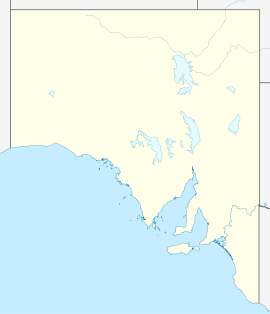- Coward Springs, South Australia
-
Coward Springs
South AustraliaEstablished: 1858 Coordinates: 29°24′S 136°47′E / 29.4°S 136.783°ECoordinates: 29°24′S 136°47′E / 29.4°S 136.783°E Time zone: • Summer (DST)
ACST (UTC+9:30) ACDT (UTC+10:30)
Location: 256 km (159 mi) E of Coober Pedy LGA: Outback Areas Community Development Trust State District: Stuart Federal Division: Grey Coward Springs is a former settlement and railway station in the desert in outback South Australia. It is situated on the Oodnadatta Track adjacent to the Wabma Kadarbu Mound Springs Conservation Park, 236 km from Coober Pedy.[1]
It was named in 1858 by Peter Warburton after Corporal Thomas Coward, one of the members of the exploration party.[2]
Coward Springs had a school from 1888 to 1890. The government bore was 400 feet deep and the artesian water rose 15 feet into the air from the bore.[3] The bore was completed on 16 July 1886.[4]
Coward Springs currently provides pleasant camping facilities, an open-air spa, and historical features.
Thomas Coward
Thomas (‘Tom’) Coward was born 1834 in England, third son of John and Sarah, and arrived in Adelaide with his parents and siblings on the Fairlie in 1840. He joined the goldrush to Victoria in 1851, and then returned to Adelaide where he joined the South Australia Police in 1853, riding on four successive gold escorts between Adelaide and Bendigo.
He was then posted as mounted constable to Port Augusta, Kapunda, and other country police stations, being promoted to corporal. In 1858 he was stationed at Mount Serle when he accompanied the party of Peter Warburton on one of his explorations, during which they discovered and named Coward Springs. He then accompanied Richard Graves MacDonnell on his Central Australian expedition.
After being dismissed from the SA Police in 1860 for gross ill-treatment of his horse, he joined the Snowy River gold escort service in New South Wales. Coward was then sent into Queensland as detective in the manhunt for the bushranger Frank Gardiner. In 1864 he resigned his NSW post to take up the position of sub-inspector in the Queensland Native Police Corps, serving at various country postings including Burketown.[5] In 1867 he was appointed goldfields warden at the Palmer River diggings, being involved in controversial actions regarding Chinese miners.[6] He then resigned from policing and married at Brisbane in 1879 to Millicent Deagon.
In 1891 Coward returned with his family to Adelaide, where he became a publican, first of the Imperial Hotel, and then of the Prince Albert Hotel, where he died in 1905, aged 71.[7] In 1893 he stood as candidate for the Northern Territory electorate in the SA House of Assembly election, but was defeated.
References
- ^ "How to get there". Coward Springs Campground. http://www.cowardsprings.com.au/getthere.php. Retrieved 2008-06-24.
- ^ "Coward Springs". PlaceNames Online, South Australian State Gazetteer. Government of South Australia, Department for Transport, Energy and Infrastructure. http://www.placenames.sa.gov.au/pno/pnores.phtml?recno=SA0016561. Retrieved 2008-06-24.[dead link]
- ^ "Place Names of South Australia - C". Manning Index of South Australian History. State Library of South Australia. http://www.slsa.sa.gov.au/manning/pn/c/c14.htm#cowardS. Retrieved 2008-06-24.
- ^ "Coward Springs". Flinders Ranges Research. http://www.southaustralianhistory.com.au/cowardsprings.htm. Retrieved 2008-06-24.
- ^ Coward's portrait, in uniform, is available for viewing at State Library of Queensland website, Image No.147040.
- ^ The secret war: a true history of Queensland's native police, by Jonathon Richards.
- ^ Obituary, The Advertiser, 6 July 1905, page 8.
Categories:- Towns in South Australia
- Ghost towns in South Australia
Wikimedia Foundation. 2010.

